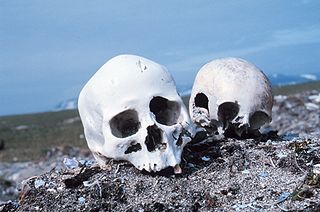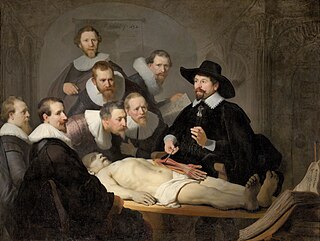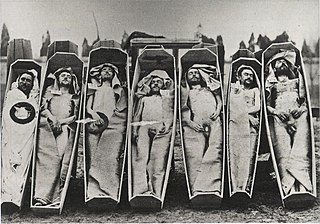Related Research Articles

Hydrostatic shock is the controversial concept that a penetrating projectile can produce a pressure wave that causes "remote neural damage", "subtle damage in neural tissues" and/or "rapid incapacitating effects" in living targets. It has also been suggested that pressure wave effects can cause indirect bone fractures at a distance from the projectile path, although it was later demonstrated that indirect bone fractures are caused by temporary cavity effects.

Pathology is the study of the causes and effects of disease or injury. The word pathology also refers to the study of disease in general, incorporating a wide range of biology research fields and medical practices. However, when used in the context of modern medical treatment, the term is often used in a narrower fashion to refer to processes and tests which fall within the contemporary medical field of "general pathology", an area which includes a number of distinct but inter-related medical specialties that diagnose disease, mostly through analysis of tissue, cell, and body fluid samples. Idiomatically, "a pathology" may also refer to the predicted or actual progression of particular diseases, and the affix pathy is sometimes used to indicate a state of disease in cases of both physical ailment and psychological conditions. A physician practicing pathology is called a pathologist.

Forensic pathology is pathology that focuses on determining the cause of death by examining a corpse. A post mortem examination is performed by a medical examiner or forensic pathologist, usually during the investigation of criminal law cases and civil law cases in some jurisdictions. Coroners and medical examiners are also frequently asked to confirm the identity of remains.

Positional asphyxia, also known as postural asphyxia, is a form of asphyxia which occurs when someone's position prevents the person from breathing adequately. People may die from positional asphyxia accidentally, when the mouth and nose are blocked, or where the chest may be unable to fully expand.
Putrefaction is the fifth stage of death, following pallor mortis, algor mortis, rigor mortis, and livor mortis. This process references the breaking down of a body of an animal such as a human post-mortem. In broad terms, it can be viewed as the decomposition of proteins, and the eventual breakdown of the cohesiveness between tissues, and the liquefaction of most organs. This is caused by the decomposition of organic matter by bacterial or fungal digestion, which causes the release of gases that infiltrate the body's tissues, and leads to the deterioration of the tissues and organs. The approximate time it takes putrefaction to occur is dependent on various factors. Internal factors that affect the rate of putrefaction include the age at which death has occurred, the overall structure and condition of the body, the cause of death, and external injuries arising before or after death. External factors include environmental temperature, moisture and air exposure, clothing, burial factors, and light exposure.

An autopsy is a surgical procedure that consists of a thorough examination of a corpse by dissection to determine the cause, mode, and manner of death or to evaluate any disease or injury that may be present for research or educational purposes.. Autopsies are usually performed by a specialized medical doctor called a pathologist. In most cases, a medical examiner or coroner can determine the cause of death, however, only a small portion of deaths require an autopsy to be performed, under certain circumstances.

Dissection is the dismembering of the body of a deceased animal or plant to study its anatomical structure. Autopsy is used in pathology and forensic medicine to determine the cause of death in humans. Less extensive dissection of plants and smaller animals preserved in a formaldehyde solution is typically carried out or demonstrated in biology and natural science classes in middle school and high school, while extensive dissections of cadavers of adults and children, both fresh and preserved are carried out by medical students in medical schools as a part of the teaching in subjects such as anatomy, pathology and forensic medicine. Consequently, dissection is typically conducted in a morgue or in an anatomy lab.
Coffin birth, also known as postmortem fetal extrusion, is the expulsion of a nonviable fetus through the vaginal opening of the decomposing body of a deceased pregnant woman due to increasing pressure from intra-abdominal gases. This kind of postmortem delivery occurs very rarely during the decomposition of a body. The practice of chemical preservation, whereby chemical preservatives and disinfectant solutions are pumped into a body to replace natural body fluids, have made the occurrence of "coffin birth" so rare that the topic is rarely mentioned in international medical discourse.

Infantile respiratory distress syndrome (IRDS), also called respiratory distress syndrome of newborn, or increasingly surfactant deficiency disorder (SDD), and previously called hyaline membrane disease (HMD), is a syndrome in premature infants caused by developmental insufficiency of pulmonary surfactant production and structural immaturity in the lungs. It can also be a consequence of neonatal infection and can result from a genetic problem with the production of surfactant-associated proteins.

Forensic biology is the application of biology to associate a person(s), whether suspect or victim, to a location, an item, another person. It can be utilized to further investigations for both criminal and civil cases. Two of the most important factors to be constantly considered throughout the collection, processing, and analysis of evidence, are the maintenance of chain of custody as well as contamination prevention, especially considering the nature of the majority of biological evidence. Forensic biology is incorporated into and is a significant aspect of numerous forensic disciplines, some of which include forensic anthropology, forensic entomology, forensic odontology, forensic pathology, forensic toxicology. When the phrase "forensic biology" is utilized, it is often regarded as synonymous with DNA analysis of biological evidence.
The following outline is provided as an overview of and topical guide to forensic science:

A cadaver or corpse is a dead human body that is used by medical students, physicians and other scientists to study anatomy, identify disease sites, determine causes of death, and provide tissue to repair a defect in a living human being. Students in medical school study and dissect cadavers as a part of their education. Others who study cadavers include archaeologists and arts students.
Virtopsy is a virtual alternative to a traditional autopsy, conducted with scanning and imaging technology. The name is a portmanteau of 'virtual' and 'autopsy' and is a trademark registered to Prof. Richard Dirnhofer (de), the former head of the Institute of Forensic Medicine of the University of Bern, Switzerland.
Alveolar capillary dysplasia (ACD) is a rare, congenital diffuse lung disease characterized by abnormal blood vessels in the lungs that cause highly elevated pulmonary blood pressure and an inability to effectively oxygenate and remove carbon dioxide from the blood. ACD typically presents in newborn babies within hours of birth as rapid and labored breathing, blue-colored lips or skin, quickly leading to respiratory failure and death. Atypical forms of ACD have been reported with initially milder symptoms and survival of many months before the onset of respiratory failure or lung transplantation.
Tobacco smoking during pregnancy causes many detrimental effects on health and reproduction, in addition to the general health effects of tobacco. A number of studies have shown that tobacco use is a significant factor in miscarriages among pregnant smokers, and that it contributes to a number of other threats to the health of the foetus.
Werner Uri Spitz is a German-American forensic pathologist who has worked on a number of high-profile cases, including the investigations of the assassinations of president John F. Kennedy and Martin Luther King Jr. He also testified at the trials of Casey Anthony and Phil Spector, the 1996 civil trial against O. J. Simpson, and consulted on the investigation of JonBenét Ramsey's 1996 death.
Purvi Patel is an Indian American whose conviction and sentence to 20 years in prison in Indiana for feticide and child neglect was overturned by the Indiana Court of Appeals. The court pointed out that the lower court's ruling had been an "abrupt departure" from the intent of the feticide law as shown by prior usage, which consisted of cases in which a pregnant woman and her unborn child were the victims of violence. The court also said that it was not possible to claim that lawmakers had intended the feticide law to be used to prosecute women trying to abort because the state abortion laws had already since the 1800s explicitly protected pregnant women from prosecution. "The state's about-face in this proceeding is unsettling, as well as untenable" under prior court precedent, Judge Terry Crone wrote in the ruling. The court said that Patel endangered the child by not seeking medical care but that prosecutors failed to prove that her failure to do so resulted in the child's death.
Post-mortem chemistry, also called necrochemistry or death chemistry, is a subdiscipline of chemistry in which the chemical structures, reactions, processes and parameters of a dead organism is investigated. Post-mortem chemistry plays a significant role in forensic pathology. Biochemical analyses of vitreous humor, cerebrospinal fluid, blood and urine is important in determining the cause of death or in elucidating forensic cases.
The necrobiome has been defined as the community of species associated with decaying corpse remains. The process of decomposition is complex. Microbes decompose cadavers, but other organisms including fungi, nematodes, insects, and larger scavenger animals also contribute. Once the immune system is no longer active, microbes colonizing the intestines and lungs decompose their respective tissues and then travel throughout the body via the blood and lymphatic systems to break down other tissue and bone. During this process, gases are released as a by-product and accumulate, causing bloating. Eventually, the gases seep through the body's wounds and natural openings, providing a way for some microbes to exit from the inside of the cadaver and inhabit the outside. The microbial communities colonizing the internal organs of a cadaver are referred to as the thanatomicrobiome. The region outside of the cadaver that is exposed to the external environment is referred to as the epinecrotic portion of the necrobiome, and is especially important when determining the time and location of death for an individual. Different microbes play specific roles during each stage of the decomposition process. The microbes that will colonize the cadaver and the rate of their activity are determined by the cadaver itself and the cadaver's surrounding environmental conditions.
The stages of death of a human being have medical, biochemical and legal aspects. The term taphonomy from palaeontology applies to the fate of all kinds of remains of organisms, with forensic taphonomy concerned for remains of the human body.
References
- ↑ Hart, Alexandra (2008). "Docimasia pulmonum hydrostatica: From Galen to Ploucquet and back again". Historia Medicinae. 1 (1): E04. ISSN 1946-3316.
- ↑ Clark, Werner U.; Spitz, Daniel J. (2004). Spitz and Fisher's Medicolegal Investigation of Death: Guidelines for the Application of Pathology to Crime Investigation (4th ed.). Springfield, Ill.: Charles C. Thomas. p. 347. ISBN 0-398-07544-1.
- ↑ "UK Professor Disproves Float Test to Seek Justice for Jailed Women in El Salvador". University of Kentucky. October 28, 2014.
- ↑ Große Ostendorf AL, Rothschild MA, Müller AM, Banaschak S (March 2013). "Is the lung floating test a valuable tool or obsolete? A prospective autopsy study". International Journal of Legal Medicine. 127 (2): 447–51. doi:10.1007/s00414-012-0727-1. PMID 22733108. S2CID 27497304.
- ↑ Moar, JJ (March 1997). "The hydrostatic test--a valid method of determining live birth?". The American Journal of Forensic Medicine and Pathology. 18 (1): 109–10. doi:10.1097/00000433-199703000-00027. PMID 9095314.
- ↑ Smith, Sydney (1951). "History and Development of Forensic Medicine". British Medical Journal. 1 (4707): 599–607. doi:10.1136/bmj.1.4707.599. PMC 2068548 . PMID 14821487.
- ↑ Hirt, M.; Kovác, P.; Matejů, E. (October 2005). "History of Forensic Medicine – the Third Part. The Development and History of Forensic Medical Science in Middle Europe". Soud Lek. 50 (4): 57–60. PMID 16381303.
- ↑ Alfsen, G. Cecilie; Ellingsen, Christian Lycke; Hernæs, Lotte (2013). ""The child has lived and breathed." Forensic examinations of newborns 1910–1912". Tidsskrift for den Norske Laegeforening. 133 (23/24): 2498–2501. doi: 10.4045/tidsskr.13.0898 . PMID 24326503.
- ↑ Le Roux-Kemp, Andra; Wilkinson, Jacques (2012). "A novel application of the hydrostatic test in determining live (non)-birth". South African Journal of Criminal Justice (2): 271–285.
- ↑ Becker, Ronald F.; Dutelle, Aric W. (2013). Criminal Investigation (4th ed.). Burlington, Mass.: Jones & Bartlett Learning. p. 253. ISBN 978-1-4496-0215-4.